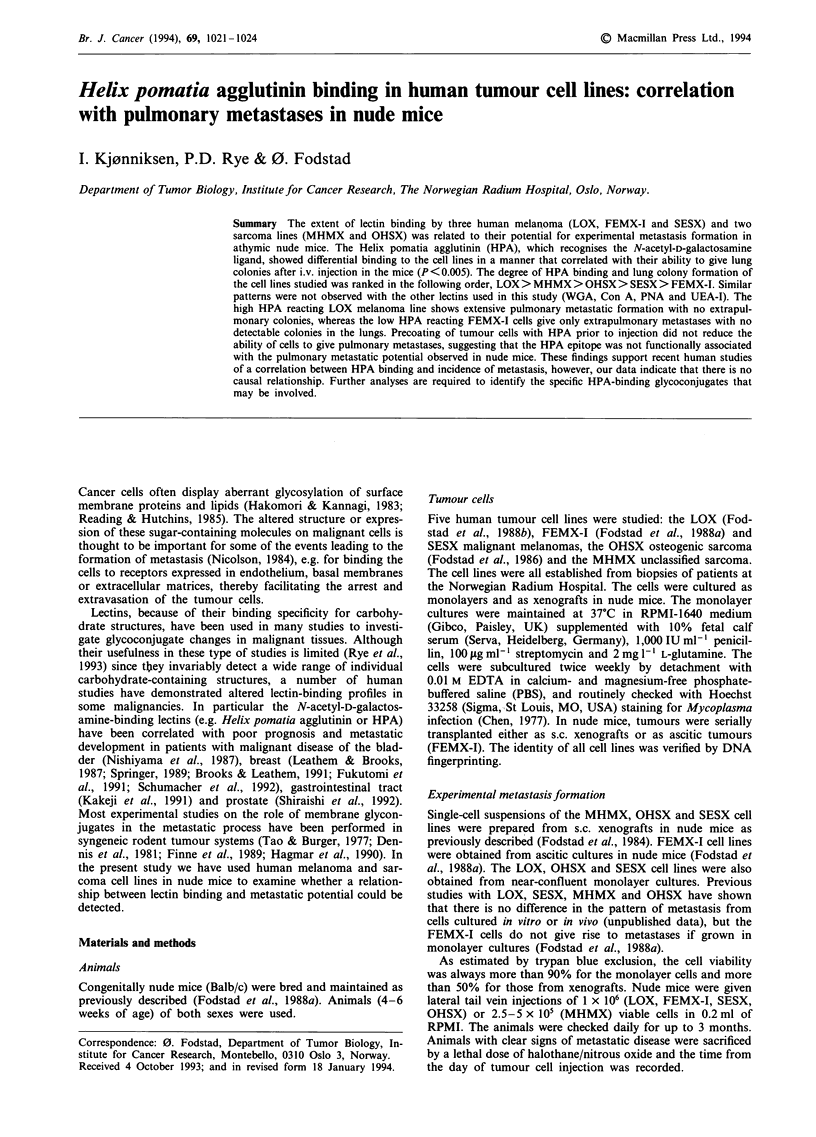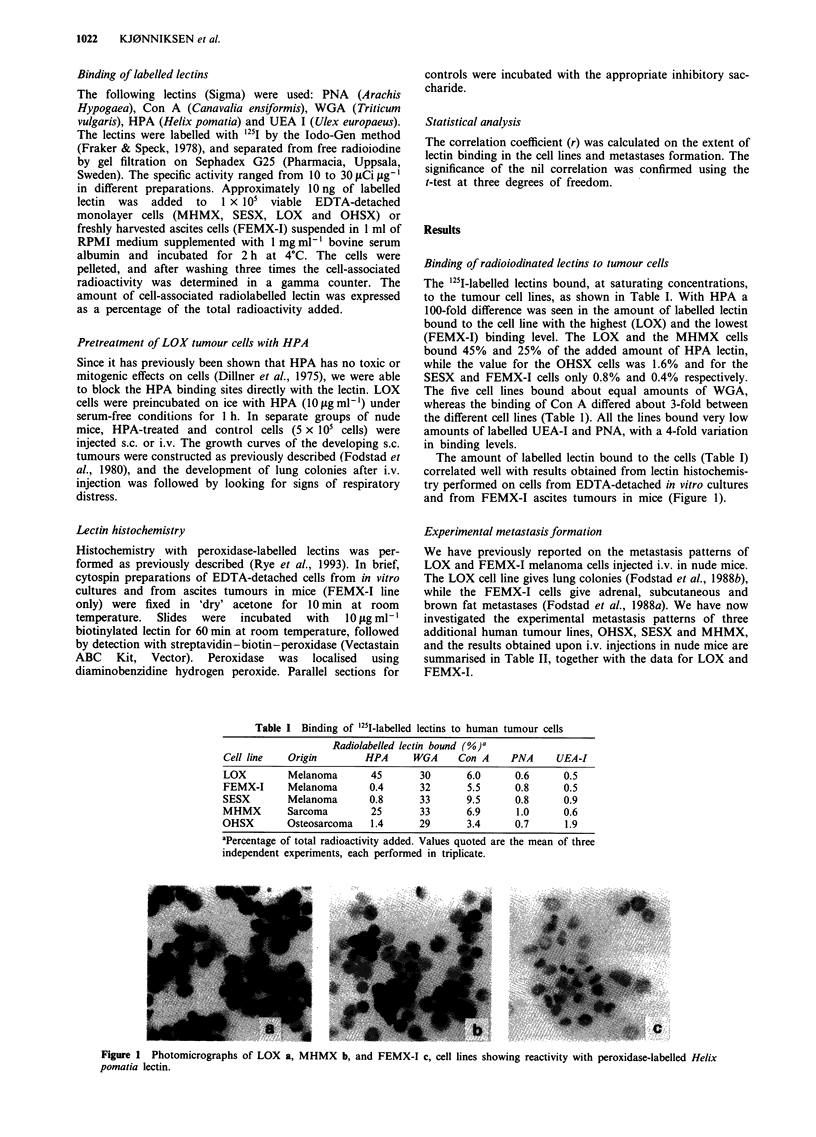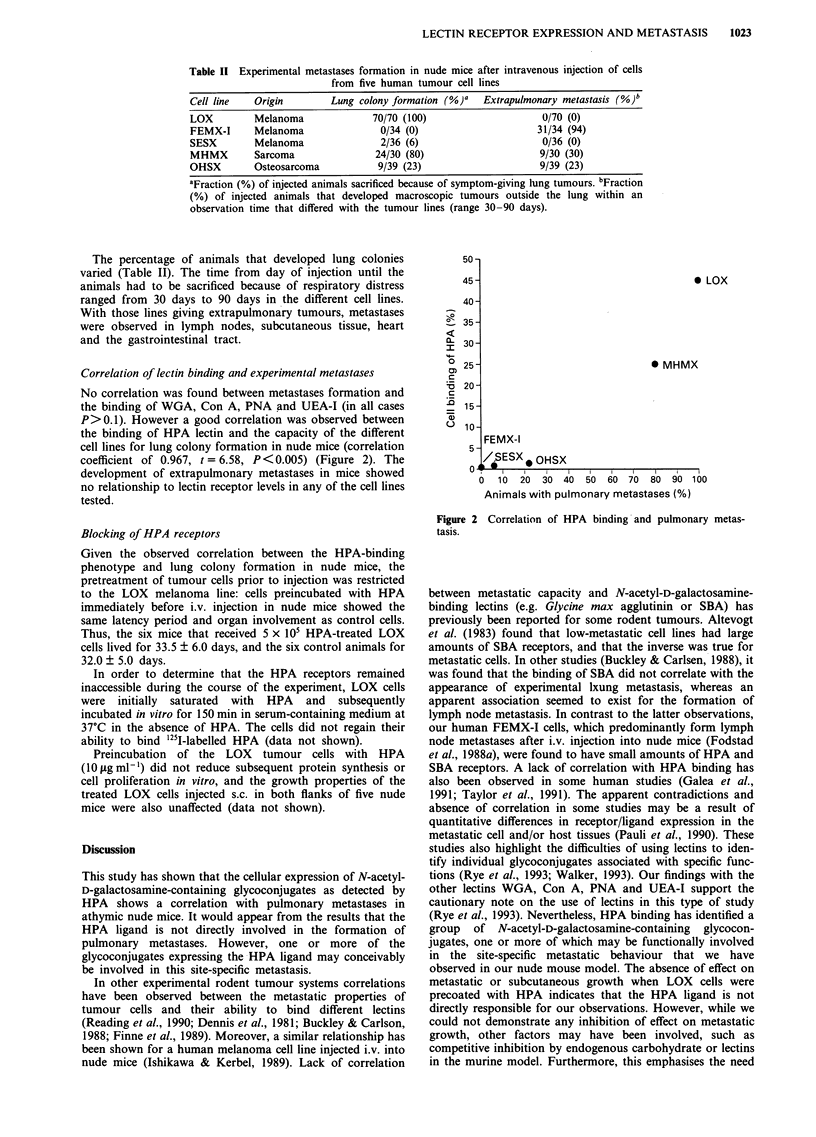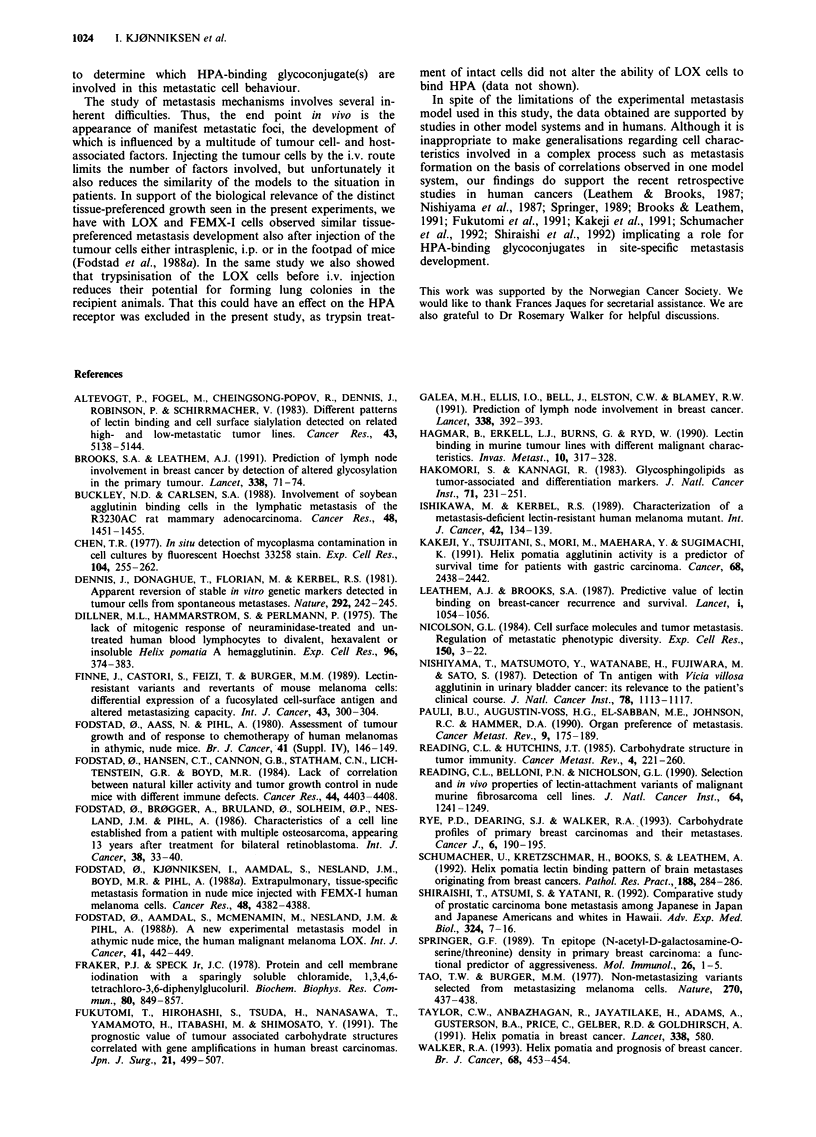Abstract
The extent of lectin binding by three human melanoma (LOX, FEMX-1 and SESX) and two sarcoma lines (MHMX and OHSX) was related to their potential for experimental metastasis formation in athymic nude mice. The Helix pomatia agglutinin (HPA), which recognises the N-acetyl-D-galactosamine ligand, showed differential binding to the cell lines in a manner that correlated with their ability to give lung colonies after i.v. injection in the mice (P < 0.005). The degree of HPA binding and lung colony formation of the cell lines studied was ranked in the following order, LOX > MHMX > OHSX > SESX > FEMX-I. Similar patterns were not observed with the other lectins used in this study (WGA, Con A, PNA and UEA-I). The high HPA reacting LOX melanoma line shows extensive pulmonary metastatic formation with no extrapulmonary colonies, whereas the low HPA reacting FEMX-I cells give only extrapulmonary metastases with no detectable colonies in the lungs. Precoating of tumour cells with HPA prior to injection did not reduce the ability of cells to give pulmonary metastases, suggesting that the HPA epitope was not functionally associated with the pulmonary metastatic potential observed in nude mice. These findings support recent human studies of a correlation between HPA binding and incidence of metastasis, however, our data indicate that there is no causal relationship. Further analyses are required to identify the specific HPA-binding glycoconjugates that may be involved.
Full text
PDF



Images in this article
Selected References
These references are in PubMed. This may not be the complete list of references from this article.
- Altevogt P., Fogel M., Cheingsong-Popov R., Dennis J., Robinson P., Schirrmacher V. Different patterns of lectin binding and cell surface sialylation detected on related high- and low-metastatic tumor lines. Cancer Res. 1983 Nov;43(11):5138–5144. [PubMed] [Google Scholar]
- Brooks S. A., Leathem A. J. Prediction of lymph node involvement in breast cancer by detection of altered glycosylation in the primary tumour. Lancet. 1991 Jul 13;338(8759):71–74. doi: 10.1016/0140-6736(91)90071-v. [DOI] [PubMed] [Google Scholar]
- Buckley N. D., Carlsen S. A. Involvement of soybean agglutinin binding cells in the lymphatic metastasis of the R3230AC rat mammary adenocarcinoma. Cancer Res. 1988 Mar 15;48(6):1451–1455. [PubMed] [Google Scholar]
- Chen T. R. In situ detection of mycoplasma contamination in cell cultures by fluorescent Hoechst 33258 stain. Exp Cell Res. 1977 Feb;104(2):255–262. doi: 10.1016/0014-4827(77)90089-1. [DOI] [PubMed] [Google Scholar]
- Dennis J., Donaghue T., Florian M., Kerbel R. S. Apparent reversion of stable in vitro genetic markers detected in tumour cells from spontaneous metastases. Nature. 1981 Jul 16;292(5820):242–245. doi: 10.1038/292242a0. [DOI] [PubMed] [Google Scholar]
- Dillner M. L., Hammarström S., Perlmann P. The lack of mitogenic response of neuraminidase-treated and untreated human blood lymphocytes to divalent, hexavalent, or insoluble Helix pomatia a hemagglutinin. Exp Cell Res. 1975 Dec;96(2):374–382. doi: 10.1016/0014-4827(75)90270-0. [DOI] [PubMed] [Google Scholar]
- Finne J., Castori S., Feizi T., Burger M. M. Lectin-resistant variants and revertants of mouse melanoma cells: differential expression of a fucosylated cell-surface antigen and altered metastasizing capacity. Int J Cancer. 1989 Feb 15;43(2):300–304. doi: 10.1002/ijc.2910430223. [DOI] [PubMed] [Google Scholar]
- Fodstad O., Aamdal S., McMenamin M., Nesland J. M., Pihl A. A new experimental metastasis model in athymic nude mice, the human malignant melanoma LOX. Int J Cancer. 1988 Mar 15;41(3):442–449. doi: 10.1002/ijc.2910410322. [DOI] [PubMed] [Google Scholar]
- Fodstad O., Aass N., Pihl A. Assessment of tumour growth and of response to chemotherapy of human melanomas in athymic, nude mice. Br J Cancer Suppl. 1980 Apr;4:146–149. [PMC free article] [PubMed] [Google Scholar]
- Fodstad O., Brøgger A., Bruland O., Solheim O. P., Nesland J. M., Pihl A. Characteristics of a cell line established from a patient with multiple osteosarcoma, appearing 13 years after treatment for bilateral retinoblastoma. Int J Cancer. 1986 Jul 15;38(1):33–40. doi: 10.1002/ijc.2910380107. [DOI] [PubMed] [Google Scholar]
- Fodstad O., Hansen C. T., Cannon G. B., Statham C. N., Lichtenstein G. R., Boyd M. R. Lack of correlation between natural killer activity and tumor growth control in nude mice with different immune defects. Cancer Res. 1984 Oct;44(10):4403–4408. [PubMed] [Google Scholar]
- Fodstad O., Kjønniksen I., Aamdal S., Nesland J. M., Boyd M. R., Pihl A. Extrapulmonary, tissue-specific metastasis formation in nude mice injected with FEMX-I human melanoma cells. Cancer Res. 1988 Aug 1;48(15):4382–4388. [PubMed] [Google Scholar]
- Fraker P. J., Speck J. C., Jr Protein and cell membrane iodinations with a sparingly soluble chloroamide, 1,3,4,6-tetrachloro-3a,6a-diphrenylglycoluril. Biochem Biophys Res Commun. 1978 Feb 28;80(4):849–857. doi: 10.1016/0006-291x(78)91322-0. [DOI] [PubMed] [Google Scholar]
- Fukutomi T., Hirohashi S., Tsuda H., Nanasawa T., Yamamoto H., Itabashi M., Shimosato Y. The prognostic value of tumor-associated carbohydrate structures correlated with gene amplifications in human breast carcinomas. Jpn J Surg. 1991 Sep;21(5):499–507. doi: 10.1007/BF02470985. [DOI] [PubMed] [Google Scholar]
- Hagmar B., Erkell L. J., Burns G., Ryd W. Lectin binding in murine tumour lines with different malignant characteristics. Effect of enzyme (pronase, neuraminidase) treatment on lectin labelling. Invasion Metastasis. 1990;10(6):317–328. [PubMed] [Google Scholar]
- Hakomori S., Kannagi R. Glycosphingolipids as tumor-associated and differentiation markers. J Natl Cancer Inst. 1983 Aug;71(2):231–251. [PubMed] [Google Scholar]
- Ishikawa M., Kerbel R. S. Characterization of a metastasis-deficient lectin-resistant human melanoma mutant. Int J Cancer. 1989 Jan 15;43(1):134–139. doi: 10.1002/ijc.2910430125. [DOI] [PubMed] [Google Scholar]
- Kakeji Y., Tsujitani S., Mori M., Maehara Y., Sugimachi K. Helix pomatia agglutinin binding activity is a predictor of survival time for patients with gastric carcinoma. Cancer. 1991 Dec 1;68(11):2438–2442. doi: 10.1002/1097-0142(19911201)68:11<2438::aid-cncr2820681119>3.0.co;2-#. [DOI] [PubMed] [Google Scholar]
- Leathem A. J., Brooks S. A. Predictive value of lectin binding on breast-cancer recurrence and survival. Lancet. 1987 May 9;1(8541):1054–1056. doi: 10.1016/s0140-6736(87)90482-x. [DOI] [PubMed] [Google Scholar]
- Nicolson G. L. Cell surface molecules and tumor metastasis. Regulation of metastatic phenotypic diversity. Exp Cell Res. 1984 Jan;150(1):3–22. doi: 10.1016/0014-4827(84)90696-7. [DOI] [PubMed] [Google Scholar]
- Nishiyama T., Matsumoto Y., Watanabe H., Fujiwara M., Sato S. Detection of Tn antigen with Vicia villosa agglutinin in urinary bladder cancer: its relevance to the patient's clinical course. J Natl Cancer Inst. 1987 Jun;78(6):1113–1118. [PubMed] [Google Scholar]
- Pauli B. U., Augustin-Voss H. G., el-Sabban M. E., Johnson R. C., Hammer D. A. Organ-preference of metastasis. The role of endothelial cell adhesion molecules. Cancer Metastasis Rev. 1990 Nov;9(3):175–189. doi: 10.1007/BF00046359. [DOI] [PubMed] [Google Scholar]
- Prediction of lymph node involvement in breast cancer. Lancet. 1991 Aug 10;338(8763):392–393. [PubMed] [Google Scholar]
- Reading C. L., Belloni P. N., Nicolson G. L. Selection and in vivo properties of lectin-attachment variants of malignant murine lymphosarcoma cell lines. J Natl Cancer Inst. 1980 May;64(5):1241–1249. [PubMed] [Google Scholar]
- Reading C. L., Hutchins J. T. Carbohydrate structure in tumor immunity. Cancer Metastasis Rev. 1985;4(3):221–260. doi: 10.1007/BF00048097. [DOI] [PubMed] [Google Scholar]
- Schumacher U., Kretzschmar H., Brooks S., Leathem A. Helix pomatia lectin binding pattern of brain metastases originating from breast cancers. Pathol Res Pract. 1992 Apr;188(3):284–286. doi: 10.1016/s0344-0338(11)81205-7. [DOI] [PubMed] [Google Scholar]
- Shiraishi T., Atsumi S., Yatani R. Comparative study of prostatic carcinoma bone metastasis among Japanese in Japan and Japanese Americans and whites in Hawaii. Adv Exp Med Biol. 1992;324:7–16. doi: 10.1007/978-1-4615-3398-6_2. [DOI] [PubMed] [Google Scholar]
- Springer G. F. Tn epitope (N-acetyl-D-galactosamine alpha-O-serine/threonine) density in primary breast carcinoma: a functional predictor of aggressiveness. Mol Immunol. 1989 Jan;26(1):1–5. doi: 10.1016/0161-5890(89)90013-8. [DOI] [PubMed] [Google Scholar]
- Tao T. W., Burger M. M. Non-metastasising variants selected from metastasising melanoma cells. Nature. 1977 Dec 1;270(5636):437–438. doi: 10.1038/270437a0. [DOI] [PubMed] [Google Scholar]
- Taylor C. W., Anbazhagan R., Jayatilake H., Adams A., Gusterson B. A., Price K., Gelber R. D., Goldhirsch A. Helix pomatia in breast cancer. Lancet. 1991 Aug 31;338(8766):580–581. doi: 10.1016/0140-6736(91)91154-m. [DOI] [PubMed] [Google Scholar]
- Walker R. A. Helix pomatia and prognosis of breast cancer. Br J Cancer. 1993 Sep;68(3):453–454. doi: 10.1038/bjc.1993.367. [DOI] [PMC free article] [PubMed] [Google Scholar]



